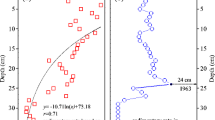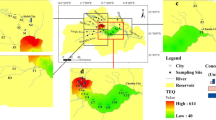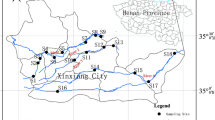Abstract
16 Polycyclic aromatic hydrocarbons (PAHs) in 20 surface sediments from Yantai offshore area were measured. The total PAHs concentrations varied from 450.0 to 4,299.0 ng/g, with a mean of 2,492.9 ng/g. The high molecular weight (HMW) PAHs were most abundant and the ratio ranged from 54.9 % to 81.6 % in all sampling stations, indicating that pyrogenic sources were a predominant contribution to PAHs pollution. The source contributions of PAHs were estimated based on the EPA Unmix 6.0 receptor model. The data were well simulated due to a high correlation coefficient between predicted and measured PAHs concentration (R2 = 0.99). A mixed source of coal combustion and traffic pollution contributed to 38.9 % of the measured PAHs, followed by diesel emission (38.8 %) and a mixed source of biomass combustion and gasoline engine emissions (22.3 %). The current findings further validated that Unmix model could be applied to apportion the sources of PAHs in sediments.



Similar content being viewed by others
References
Barakat AO, Mostafa A, Wade TL, Sweet ST, El Sayed NB (2011) Distribution and characteristics of PAHs in sediments from the Mediterranean coastal environment of Egypt. Mar Pollut Bull 62(9):1969–1978
Harrison RM, Smith DJT, Luhana L (1996) Source apportionment of atmospheric polycyclic sromatic hydrocarbons collected from an urban location in birmingham, U.K. Environ Sci Technol 30(3):825–832
Henry RC (2003) Multivariate receptor modeling by N-dimensional edge detection. Chemometr Intell Lab 65(2):179–189
Henry, RC (2007) EPA Unmix 6.0 fundamentals and user guide. US Environmental Protection Agency. http://www.epa.gov/heasd/documents/unmix-6-user-manual.pdf
Henry RC, Christensen ER (2010) Selecting an appropriate multivariate source apportionment model result. Environ Earth Sci 44(7):2474–2481
Hopke PK (2003) Recent developments in receptor modeling. J Chemometr 17(5):255–265
Hu NJ, Shi XF, Liu JH, Huang P, Liu YG, Liu Y (2010) Concentrations and possible sources of PAHs in sediments from Bohai Bay and adjacent shelf. Environ Earth Sci 60(8):1771–1782
Khalili NR, Scheff PA, Holsen TM (1995) PAH source fingerprints for coke ovens, diesel and, gasoline engines, highway tunnels, and wood combustion emissions. Atmos Environ 29(4):533–542
Lang YH, Yang X, Wang H, Yang W, Li GL (2013) Diagnostic ratios and positive matrix factorization to identify potential sources of PAHs in sediments of the Rizhao offshore. China, Polycyclic Aromat Compd 33(2):161–172
Li CK, Kamens RM (1993) The use of polycyclic aromatic hydrocarbons as source signatures in receptor modeling. Atmos Environ 27(4):523–532
Liu AX, Lang YH, Xue LD, Liu J (2009) Ecological risk analysis of polycyclic aromatic hydrocarbons (PAHs) in surface sediments from Laizhou Bay. Environ Monit Assess 159(1–4):429–436
Mai BX, Fu JM, Sheng GY, Kang YH, Lin Z, Zhang G, Min YS, Zeng EY (2002) Chlorinated and polycyclic aromatic hydrocarbons in riverine and estuarine sediments from Pearl River Delta. China. Environ Pollu 117(2002):457–474
Mai BX, Qi SH, Zeng EY, Yang QS, Zhang G, Fu JM, Sheng GY, Peng PG, Wang ZS (2003) Distribution of polycyclic aromatic hydrocarbons in the coastal region off Macao, China: assessment of input sources and transport pathways using compositional analysis. Environ Sci Technol 37(21):4855–4863
Pietzsch R, Patchineelam SR, Torres JPM (2010) Polycyclic aromatic hydrocarbons in recent sediments from a subtropical estuary in Brazil. Mar Chem 118(1–2):56–66
Shi GL, Tian YZ, Guo CS, Feng YC, Xu J, Zhang Y (2012) Sediment–pore water partition of PAH source contributions to the Yellow River using two receptor models. J Soil Sediment 12(7):1154–1163
Zhang Y, Guo CS, Xu J, Tian YZ, Shi GL, Feng YC (2012) Potential source contributions and risk assessment of PAHs in sediments from Taihu Lake, China: comparison of three receptor models. Water Res 46(9):3065–3073
Acknowledgments
This work was supported by Program for New Century Excellent Talents in University (NCET-10-0758) and National Natural Science Foundation of China (40706039).
Author information
Authors and Affiliations
Corresponding author
Rights and permissions
About this article
Cite this article
Lang, Yh., Yang, W. Source Apportionment of PAHs Using Unmix Model for Yantai Costal Surface Sediments, China. Bull Environ Contam Toxicol 92, 30–35 (2014). https://doi.org/10.1007/s00128-013-1164-7
Received:
Accepted:
Published:
Issue Date:
DOI: https://doi.org/10.1007/s00128-013-1164-7




